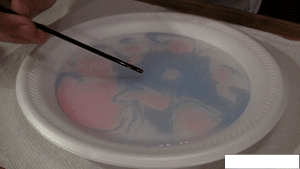Surface Tension Art
 WATCH SCIENTIST JOE PERFORM THIS EXPERIMENT HERE!
WATCH SCIENTIST JOE PERFORM THIS EXPERIMENT HERE!
Materials:
- Acrylic paints
- Straws, small paint brushes, or short pieces of yarn
- A toothpick
- Water
- A plate or plastic container
- Dish soap
- Artists’ paper (sketchpad paper, watercolor paper, or Bristol board work well)
- Cups or containers for paint and soap
Instructions:
- Cover your work surface with paper towels.
- In the cups, mix two or three paint colors with water in roughly equal parts.
- Add a drop of soap and a few drops of water to another cup.
- Pour enough water onto the plate to cover the bottom.
- Using the straws, add drops of paint to the surface of the water by dipping a straw into a paint cup then gently touching the surface of the water with the straw.
- Use a toothpick dipped in soap to break up the paint colors and form patterns.
- Take a piece of paper small enough to fit on the surface of the water and lay it gently in the center of the plate. Let it soak for 5-10 seconds, then carefully lift it off and set it onto a paper towel. Use another paper towel to gently pat the surface of the paper dry.
WATCH THE QUICK AND EASY VIDEO TUTORIAL
How it Works:
The surface of the water is made up of millions of water molecules. These tiny molecules like to be together, and create surface tension where they meet the air. Surface tension keeps the paint from sinking (mostly). This is how water beetles stay on the surface of ponds and rivers without sinking!
Extra Experiments:
-
- Try different colors to see which ones show up well.
- Acrylic paints aren’t the only types that work with this method. Oil paints and watercolors may work, certain nail polishes give very colorful results (new polishes work better than old bottles, creamy colors tend to work better than transparent ones).
EXPLORE TONS OF FUN AND EASY SCIENCE EXPERIMENTS!
SUBSCRIBE AND NEVER MISS A NEW SCIENCE FUN VIDEO!

